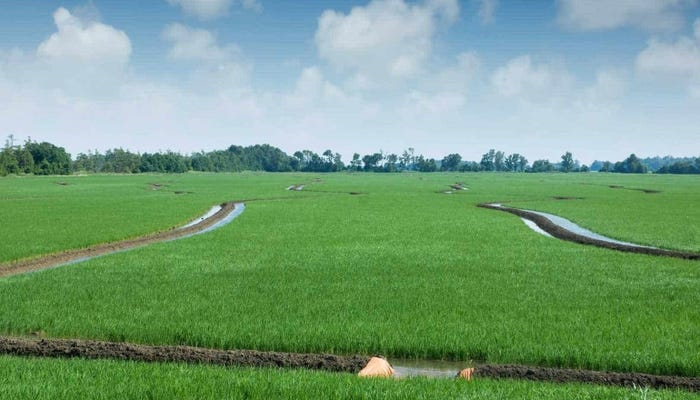
Sponsored Content
TA Rice Farmer’s True Cost of ‘Peace of Mind’
By Tom Wood, General Manager at Belchim Crop Protection USA
The total number of rice farms and acreage in the US has decreased from 1995 to 2017 yet total rice production has grown. This growth in the market can be primarily attributed to economies of overarching scale and the adoption of new technologies.
The rice farming industry has seen the introduction of new rice seed varieties, causing the most significant shift in product the market has ever seen. Precision farming technologies proliferated, such as yield monitors and guidance systems for tractors. Per-acre production costs are higher but so too are rice yields. The introduction of new technologies and methods has resulted in a more productive, accurate, and thriving farm environment.
And yet, despite this increasing sophistication, farmers still struggle with the age-old scourge of rice stink bugs (RSB). On the one hand, this pest causes significant economic losses by reducing yields by removing a grain's content in the milk stage of development. And on the other hand, the result of ‘pecky rice’ is also a real issue as it has the most significant impact on the quality of the rice and its marketability.
While effective to some degree, most current insecticides and pesticides do not provide a long-term solution. In fact, in recent discussions with university experts across the delta region, many expressed the serious frustration farmers have had with RSB and pyrethroid resistance. The failure of pyrethroids from 2020 to 2021 was a drastic shift in normal trends farmers are accustomed to. We were told that the largest region in the delta, Arkansas, saw an increase in pyrethroid resistance that encapsulated nearly the entire state.
This shouldn’t come as a total surprise to us all. We’ve known for some months that the reduced efficacy of pyrethoids haunted farmers not only this season but also last. Timing is critical as is an integrated pest management plan to help increase efficacy.
In addition to simple resistance, the use of current products on the market can harm fish and crustaceans that often form an integral and essential part of the environmental ecosystem of a farm. Research has shown that it only takes 0.01 ppm of some of these agents in water to kill 50% of the crayfish population of a pond that happens to be close to a rice field. This brings us to the models developed by the EPA. According to these models, dinotefuran insecticides are shown to be the safest of all the neurotoxic insecticides in terms of aquatic toxicity, up to 10 000 times safer than pyrethroids.

The Market Debate
Most rice acres have temporary raised beds ‘levees’ that create multiple ponds within a big field by design. Farmers then pump water into the fields to keep the rice standing in water all season and ensure that weeds and sub-soil insects are kept under control. If the water level gets too high, it can damage the rice crop and destroy the levee system, potentially devastating the entire crop. Given that rice is typically grown in hurricane-prone areas in the United States, it is a careful balancing act to treat crops while best managing water levels in preparation for a significant storm.
Further complicating this process is that hurricane season often coincides with the timing of the application of substances to control rice stink bugs. This means that a farmer must consider the impact of using a pyrethroid and run the risk of not being able to release the water from their fields for seven days. The alternative is significant financial fines and killing aquatic organisms downstream wherever the wastewater ends up. But not treating for rice stink bugs mean they can then lay eggs and cause overall rice yield loss.
Like investments made in technology over the past decades, insecticides are drawing attention to what lasting improvements new chemistries can afford farmers in more ways than one.
With several options on the market, growers are faced with a difficult choice. Typically, the least expensive option is chosen however, it tends to be more labor-intensive, causing growers to have to apply several applications within a season and to worry about timing with mother nature, which is as unpredictable as they come. This can be seen in the fields of Arkansas and by frustrated growers throughout the state. After applying two and even three trips in some cases growers faced significant resistance nonetheless and were left with little choices to combat these direct problems.
Other chemistries, such as dinotefuran, the active ingredient in Belchim USA’s Tenchu® 20 SG provide a longer residual and no buffer zone to aquatic life. Farmers can intentionally lower the water level of the field at their convenience when mother nature signals and there is no cause for concern with hurting the aquatic life close by, nor the hefty fines assigned by the EPA.
The Results
For farmers, the health of the natural surroundings is critically important. To ensure the longevity of crops and because they hunt and fish on the land, they need to use chemical pesticides that are safe for aquatic life. The introduction of more sophisticated pesticides, albeit more expensive, alleviates any concerns about harming the environment. Rice farming has undergone massive change over the past 21 years and will continue to do as the world’s population increases. The land is not going anywhere, but the food produced from it must continue to keep pace, and with that, so too must farmers work harder.
Comparable to when technologies are introduced that make a farmer’s day that much easier, newer and better-designed pesticides deliver similar results. Peace of mind decreases time in the field, has no impact on fish and crustaceans and is more effective than traditional rice stink bugs measures.
Henry Ford once said, “stopping advertising to save money is like stopping your watch to save time.” It makes little sense to relinquish hard work towards a lower price tag. It is paramount that with open arms, we embrace new tools and technologies that leverage farmers’ extensive experience in the field and answers the needs of a modern age.
About the Author(s)
You May Also Like




